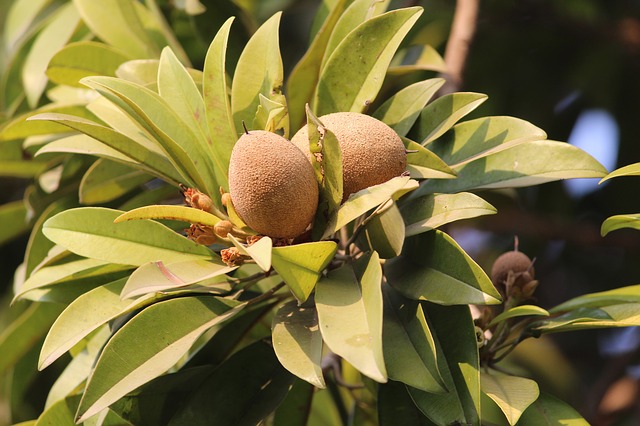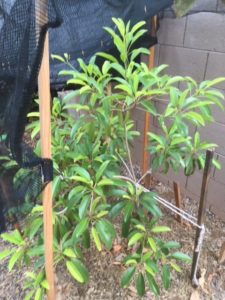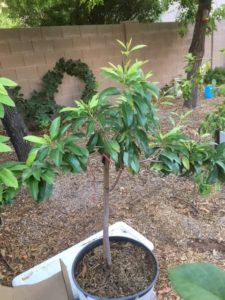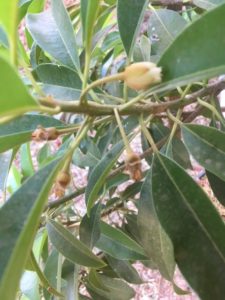Growing Sapodilla in Hot, Dry Climates (Chikoo)

When I started getting into tropical fruit trees I began to go to various ethnic grocery stores to try different types of fruit that I had never tasted before.
I know that store bought fruit isn’t always at optimal quality, but at least it gives you an inclining if you would like a fruit or not.
One of the fruits that I was excited to try was Sapodilla. When I tried Sapodilla for the first time, I absolutely loved it. It has become one of my favorite fruits and I had to plant a Sapodilla tree or Chikoo of my own.
Let’s take a look at growing Sapodilla in hot, dry climates like my yard in the Arizona Desert.
In my yard, I have what I believe to be a Tikal Sapodilla and also a Silas Woods Sapodilla.
Tikal Sapodilla
I purchased my Tikal Sapodilla at a local nursery in a 3 gallon size. This tree and I have quite a history together. I purchased the tree in the spring of 2016 and originally intended to grow it in a container.
Well one summer day, I decided I had a good spot in the yard for it and planted it in the ground. We decided shortly after planting it that we were going to put our house up for sale, so there was no way I was leaving it behind.
I dug it up and kept it in a container for that winter, then planted it in the ground the next spring. Needless to say, the tree has taken some abuse and did have periods where it showed.
It’s now doing well, but it’s in a location near my AC unit, so the air from the AC tends to blow on it, which isn’t good in the dry heat or cold winter nights. I’m working on figuring something out.
Tikal Sapodilla tends to flower a couple times of year in spring and late summer. I had one fruit set in the second year, but a windstorm blew it off.

Silas Woods Sapodilla
This is a variety I’m extremely excited about. It’s a dwarf variety that is supposed to fruit prolifically, even at a small size. I purchased mine in fall of 2016 as a mail order plant and it was around a foot tall.
It has flowered in its first two years in the spring, but hasn’t set fruit. In more humid climates, like South Florida, this variety tends to fruit year round, but I’ve only seen it flower in the spring in my area.
I’m concerned that maybe it needs more humidity during flowering to set fruit. Hopefully, that isn’t the case. In summer of 2018, I had a large windstorm that snapped the tree in half, so it is recovering.
Sapodillas generally grow fairly slowly outside of the tropics, but the Silas Woods has definitely grown faster than my Tikal.
It may have something to do with one being in the ground and the other in a container or just all the transplanting that the Tikal went through slowed it down.

Fruiting
Sapodillas have a similar look to a small potato or kiwi. When you cut them open they have a few large seeds that are fairly flat with a hook on the end.
The texture is similar to a pear with that little bit of grit. Many people compare the taste to a pear with brown sugar or cinnamon sugar toast.
I’ve yet to have any fruit on my tree in their first two years. The flowers are supposed to be self-pollinating. A method I’ve seen to pollinate is to squeeze the blossom together, which I’ve attempted.
Gardening Skill Level
I would say that growing Sapodilla in a hot, dry climate takes a moderate skill level. It does take some effort to provide some shade, at least when the tree is young, when temps are consistently over 100 degrees.
Sapodillas are also not tolerant of frost and cold temps may also effect fruiting, so it will need some frost protection in climates that get some potential frost.
Suitable for Container Growing

Sapodillas are great for growing in a container. I would recommend a variety like Silas Woods, which is naturally dwarf, for a container, but other varieties can also be maintained in a container.
Since it grows fairly slowly it makes it easy to container grow. Be careful of putting it in too large of a pot, because the soil will hold too much water.
Make sure the roots have completely filled the pot before moving it to the next larger size pot.
RELATED POST: Growing Fruit Trees in Containers in Hot Climates
Planting Tips
Sapodillas don’t seem that particular about the soil type. As long as it’s not just sitting in water you should be fine.
Sapodillas seem to handle high PH soil or salts in the soil a lot better than some other tropical fruit trees.

Watering
I’ve read some things that have said that Sapodilla can be fairly drought tolerant. This may be the case when the tree is older, but from my experience with Sapodilla’s they need a lot of water in the hot months of my desert climate.
I’ve noticed that Sapodilla’s have shallow root systems and the roots tend to be more towards the surface, which is probably why they need frequent watering in hot, dry climates.
The leaves start to wilt when wanting water, so it is easy to identify if you need to give them watering.
RELATED POST: How to Water Fruit Trees in Hot Climates the Right Way
Feeding
I feed my Sapodilla trees the same regimen as most of my tropical fruit trees. I give them a steady dose of liquid fish and seaweed fertilizer throughout the growing season. I also periodically top with compost.
Check out the products that I use and recommend here.
Sun Exposure
I have my Tikal Sapodilla along an East facing wall so it gets shade in the later afternoon. I also utilize a shade clothe the first couple years.
My Silas Woods Sapodilla I tend to move around the yard, but primarily it gets morning sun until around noon without any shade protection and does well.
It will get some sun scorch around the edges of the leaves periodically during the hottest parts of the year.

Potential Problems
I occasionally pull stink bugs off of my Sapodilla, but rarely have seen any other pest problems. It seems virtually disease resistant and just a resilient tree overall.
One thing I’ve noticed as it tends to cycle through leaves a few times per year. Initially I was worried that I was doing something to cause it, but it just seems like a normal part of its growth cycle.
Protecting it from any potential frost damage, is the main concern growing Sapodilla outside of the tropics.
Please comment below on anything that you enjoyed from this post or experience with growing Sapodilla.

Very nice artiсle, totally wһat I was looking for.